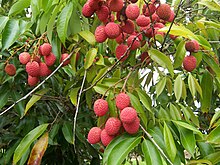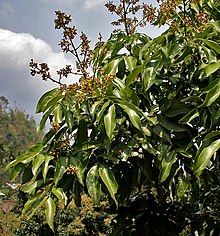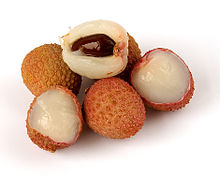| Lychee | |
|---|---|
 | |
| Scientific classification | |
| Kingdom: | Plantae |
| (unranked): | Angiosperms |
| (unranked): | Eudicots |
| (unranked): | Rosids |
| Order: | Sapindales |
| Family: | Sapindaceae |
| Subfamily: | Sapindoideae |
| Genus: | Litchi Sonn. |
| Species: | L. chinensis |
| Binomial name | |
| Litchi chinensis Sonn.[1] | |
Lychee is an evergreen tree, reaching 10–20 m tall, bearing fleshy fruits that are up to 5 cm (2.0 in) long and 4 cm (1.6 in) wide. The outside of the fruit is covered by a pink-red, roughly-textured rind that is inedible but easily removed to expose a layer of sweet, translucent white flesh. Lychees are eaten in many different dessert dishes, and are especially popular in China, throughout South-East Asia, along with South Asia.[2][3]
Lychee is cultivated in China, and in a narrow belt through Thailand, northern Vietnam, and northern India, particular Bihar which accounts for 75% of total production.[2][4] South Africa and the United States (Hawaii and Florida) also have commercial lychee production.[2]
Lychee has a history of cultivation, going back as far as 2000 BC according to records in China. Cultivation began in the area of southern China, Malaysia, and northern Vietnam. Wild trees still grow in parts of southern China and on Hainan Island. There are many stories of the fruit's use as a delicacy in the Chinese Imperial Court. It was first described and introduced to the west in 1782.[1]
Contents |
Taxonomy

Pierre Sonnerat's drawing from Voyage aux Indes Orientales et à la Chine (1782)
- Litchi chinensis subsp. chinensis is the only commercialized lychee. It grows wild in southern China, northern Vietnam, and Cambodia. It has thin twigs, flowers typically have six stamens, fruit are smooth or with protuberances up to 2 mm.
- Litchi chinensis subsp. philippinensis (Radlk.) Leenh. It is common in the wild in Phillippines and Papua New Guinea and rarely cultivated. It has thin twigs, six to seven stamens, long oval fruit with spiky protuberances up to 3 mm.
- Litchi chinensis subsp. javensis. It is only known in cultivation, in Malaysia and Indonesia. It has thick twigs, flowers with seven to eleven stamens in sessile clusters, smooth fruit with protuberances up to 1 mm.[5]
Description
L. chinensis is an evergreen tree that is frequently less than 10 m (33 ft) tall, sometimes reaching more than 15 m (49 ft). The bark is grey-black, the branches a brownish-red. Leaves are 10 to 25 cm (3.9 to 9.8 in) or longer, with leaflets in 2-4 pairs.[6] Flowers grow on a terminal inflorescence with many panicles on the current season's growth. The panicles grow in clusters of ten or more, reaching 10 to 40 cm (3.9 to 16 in) or longer, holding hundreds of small white, yellow, or green flowers that are distinctively fragrant.[5]Fruits mature in 80–112 days, depending on climate, location, and cultivar. Fruits reach up to 5 cm (2.0 in) long and 4 cm (1.6 in) wide, varying in shape from round, to ovoid, to heart-shaped. The thin, tough inedible skin is green when immature, ripening to red or pink-red, and is smooth or covered with small sharp protuberances. The skin turns brown and dry when left out after harvesting. The fleshy, edible portion of the fruit is an aril, surrounding one dark brown inedible seed that is 1 to 3.3 cm (0.39 to 1.3 in) long and .6 to 1.2 cm (0.24 to 0.47 in) wide. Some cultivars produce a high percentage of fruits with shriveled aborted seeds known as 'chicken tongues'. These fruit typically have a higher price, due to having more edible flesh.[5]
History
Cultivation of Lychee began in the region of southern China, Malaysia, and northern Vietnam. Wild trees still grow in rainforest in Guangdong province and on Hainan Island. Unofficial records in China refer to Lychee as far back as 2000 BCE.[7]In the 1st century, fresh lychees were in such demand at the Imperial Court, that a special courier service with fast horses would bring the fresh fruit from Canton. There was great demand for lychee in the Sung Dynasty (960-1279ACE), according to Ts'ai Hsiang, in his Li chi pu (Treatise on Lychees). It was also the favourite fruit of Emperor Li Longji (Xuanzong)'s favoured concubine Yang Yuhuan (Yang Guifei). The emperor had the fruit delivered at great expense to the capital.[2]
In the Chinese classical work, Shanglin Fu, it is related that the alternate name, meaning leaving its branches, is so-called because once the fruit is picked it deteriorates quickly.
The lychee was first described in the West by Pierre Sonnerat (1748–1814) on a return from his travel to China and Southeast Asia. It was then introduced to the Réunion Island in 1764 by Joseph-François Charpentier de Cossigny de Palma. It was later introduced to Madagascar which has become a major producer.
Cultivation and uses
Lychees are extensively grown in China, and also elsewhere in South-East Asia, Thailand, Laos, Cambodia, Vietnam, Pakistan, Bangladesh, India, southern Japan, and more recently in California, Hawaii, Texas, Florida,[8] the wetter areas of eastern Australia and sub-tropical regions of South Africa, Israel and also in the states of Sinaloa and San Luis Potosí (specifically, in La Huasteca) in Mexico. They require a warm subtropical to tropical climate that is cool but also frost-free or with only very slight winter frosts not below -4°C, and with high summer heat, rainfall, and humidity. Growth is best on well-drained, slightly acidic soils rich in organic matter. A wide range of cultivars is available, with early and late maturing forms suited to warmer and cooler climates respectively. They are also grown as an ornamental tree as well as for their fruit.Lychees are commonly sold fresh in Asian markets, and in recent years, also widely in supermarkets worldwide. The red rind turns dark brown when the fruit is refrigerated, but the taste is not affected. It is also sold canned year-round. The fruit can be dried with the rind intact, at which point the flesh shrinks and darkens.[2] Dried lychee are often called lychee nuts, though, of course, they are not a real nut.
According to folklore, a lychee tree that is not producing much fruit can be girdled, leading to more fruit production.
Cultivars
There are numerous lychee cultivars, with considerable confusion regarding their naming and identification. The same cultivar grown in different climates can produce very different fruit. Cultivars can also have different synonyms in various parts of the world. Southeast Asian countries, along with Australia, use the original Chinese names for the main cultivars. India grows more than a dozen different cultivars. South Africa grows mainly the 'Mauritius' cultivar. Most cultivars grown in the United States were imported from China, except for the 'Groff', which was developed in the state of Hawaii.[3]Different cultivars of lychee are popular in the varying growing regions and countries. In China, popular cultivars include: Sanyuehong, Baitangying, Baila, Shuidong, Feizixiao, Dazou, Heiye, Nuomici, Guiwei, Huaizhi, Lanzhu, and Chenzi. In Vietnam, the most popular cultivars are: Longhnan, Tieuhue, and Xuongcomvang. Florida production is based on the Hawaii cultivar Kohala. Australia predominantly grows Kohala, Chompoo, Haew, and Biew Kiew.[5] India grows more than a dozen named cultivars, including Shahi (Highest Pulp %) ,Dehra Dun, Early Large Red, Kalkattia, Rose Scented.[3][9]
Nutritional Facts
| Nutritional value per 100 g (3.5 oz) | |
|---|---|
| Energy | 276 kJ (66 kcal) |
| Carbohydrates | 16.5 g |
| Dietary fiber | 1.3 g |
| Fat | 0.4 g |
| Protein | 0.8 g |
| Vitamin C | 72 mg (120%) |
| Calcium | 5 mg (1%) |
| Magnesium | 10 mg (3%) |
| Phosphorus | 31 mg (4%) |
| Edible parts are 60% of total weight Percentages are relative to US recommendations for adults. Source: USDA Nutrient database | |
A cup of Lychee fruit provides, among other minerals, for a 2000 Calorie diet, 14%DV of copper, 9%DV of phosphorus, and 6%DV of potassium.
Lychees are low in saturated fat and sodium and are cholesterol free (like all plant-based foods) . Most of the energy in a lychee is in the form of carbohydrate (sugar). Lychees are high in polyphenols, containing 15% more than grapes, a fruit commonly referenced as high in polyphenols.[11] On the phenolic composition, flavan-3-ol monomers and dimers were the major found compounds representing about 87.0% of the phenolic compounds that declined with storage or browning. Cyanidin-3-glucoside was a major anthocyanin and represented 91.9% of anthocyanins. It also declined with storage or browning. Small amounts of malvidin-3-glucoside were also found.[12]







No comments:
Post a Comment